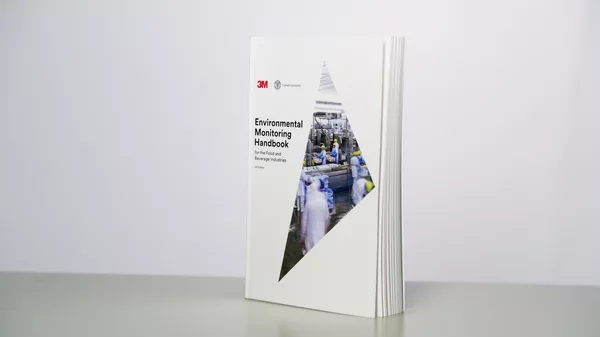A Better Plan for a Better Plant: Demystifying Environmental Monitoring

Imagine learning your processing plant environment had been scientifically linked to a salmonellosis outbreak that sickened nearly 30 people. To make matters worse, you learn that the implicated strain matched the subtype of another even more harmful outbreak involving a different product produced in the same plant 10 years ago. In other words, the microbiological culprit took residence in your plant for a full decade, all the while eluding identification and elimination.
This true story illustrates the breakdowns that too often occur with food safety and quality “prerequisite activities”—the measures manufacturers take to prevent microbiological contamination from occurring within their walls and under their watch.
In many cases, the frameworks organizing these prerequisite activities simply went too long without strategic review. Or, if they were modified, the impact was iterative. Modifications were made gradually to address new customer, regulatory, or other disparate requirements that might affect the production environment. As a result, approaches became uncoordinated and nonunified, resources weren’t optimally leveraged, and general thinking and behaviors failed to become predictive in nature.
As greater knowledge of these issues has emerged, the food industry and the authorities that regulate it have identified a new concept—environmental monitoring—to better identify and control contamination in the surrounding production, distribution, and handling environment.
And to help food and beverage manufacturers develop appropriate environmental monitoring programs and avoid costly food safety or spoilage mishaps, 3M Food Safety teamed up with Cornell University and involved other expert partners around the world to create the industry’s first, comprehensive “Environmental Monitoring Handbook,” along with a related online learning pathway.
Environmental monitoring programs can encompass a range of contamination risks. Not only pathogens, but also indicator organisms, spoilage organisms, allergens, and more, tested in different places, times, and frequencies throughout a facility. There is no “one size fits all” approach. Manufacturers must individually consider the target organisms and other specific risks that pertain to them, the nuances of their production environment, and the implications in terms of what, when, where, and how often they should conduct testing. It’s important this be maintained as a written plan and that standard operating procedures are developed, defining the specific actions to be taken should a given sample test positive for a hazard.
.png) In addition to identifying and dealing with analytes of concern and being thorough about and conversant in the nature of one’s plant environment (i.e., knowing the difference between “growth niches” and “transfer points” and where they might exist in one’s facility), a coordinated environmental program can entail many other factors. The list includes but is not limited to good manufacturing practices (GMPs), cleaning and sanitation processes, sanitary equipment and design, and the sufficiency and safety of water (potable, cooling, etc.), steam, or ice.
In addition to identifying and dealing with analytes of concern and being thorough about and conversant in the nature of one’s plant environment (i.e., knowing the difference between “growth niches” and “transfer points” and where they might exist in one’s facility), a coordinated environmental program can entail many other factors. The list includes but is not limited to good manufacturing practices (GMPs), cleaning and sanitation processes, sanitary equipment and design, and the sufficiency and safety of water (potable, cooling, etc.), steam, or ice.
Looking for quick answers on food safety topics?
Try Ask FSM, our new smart AI search tool.
Ask FSM →
The importance of the human aspect of environmental monitoring also cannot be overlooked. It’s critical to train employees to adhere to specific and consistent sample collection and recordkeeping, but also to fundamentally motivate them to maintain strong personal hygiene practices and continuously cultivate a positive culture of food safety within the organization. Company leaders may get a sense for how strong the food safety culture is when there is an unencumbered line of sight within the organization around food safety issues and employees take personal responsibility and a proactive approach to keeping unwanted microorganisms distanced as far from food as possible.
Taking Cues from HACCP
Fundamentally, environmental monitoring measures risks in the processing environment, as mentioned above, and then assesses the hurdles to controlling them. This assessment frequently relies on sampling and testing to indicate control in the facility and to expose when, where, and how failures might occur or when actions like interventions are needed to bring the process back into required levels of control.
While there is not currently a universally recognized framework for environmental monitoring, there are logical approaches that can be derived from other aspects of food safety and quality management, including Hazard Analysis and Critical Control Points (HACCP).
A HACCP-informed approach to develop purpose-driven environmental monitoring programs could, for example, start with an identification of hazards followed by a determination of which specific hazards could be transmitted through the processing environment. In so doing, manufacturers must recognize that the processing plant can be both a source and a vehicle for cross-contamination.
Control strategies, including sanitation, GMPs, sanitary equipment design, and other activities, would then be prescribed to control each hazard and would represent the equivalent of “non-process preventive controls” as found in HACCP. Subsequently, a facility could identify environmental monitoring activities needed to validate that a given non-process preventive control addresses the target hazard. Then, it would verify the effectiveness of the validated non-process preventive control to ensure consistent implementation.
Suffice it to say, it’s critical that food and beverage manufacturers remain vigilant in their validations that set proper control parameters and in their verifications that continually monitor and assure those control measures were effective.
Business Benefits
With renewed industry focus on the programs underpinning HACCP and a greater appreciation for the important role environmental monitoring plays in delivering safe products to consumers, it is imperative that food safety leaders prioritize environmental monitoring programs within their companies and invest the resources to ensure proper execution. Companies that commit to these practices not only reduce their risk exposure to product-related recalls and outbreaks, but they may encounter other positive business benefits.
For example, environmental monitoring may identify hard-to-clean areas that can be completely eliminated through equipment redesign, which subsequently enables longer production runs and less downtime. Similarly, prolonged commitment to environmental monitoring may eventually reduce the financial and sustainability costs associated with lost product, lower insurance premiums, or create new customer opportunities because order fulfillment has become more reliable and predictable.
Ultimately, longitudinal analyses should be performed on as many facets of the environmental monitoring program as possible. Companies will want to coordinate the data, producing trending charts, floor plan assessments, and other integrated outputs.
With a regular commitment to environmental monitoring and a strategic review of the data, food safety professionals will not only keep top management readily informed but maximize their overall impact and improve their odds of creating transformational outcomes.
Visit www.3M.com/VerifySafe for more resources and information on environmental monitoring.








